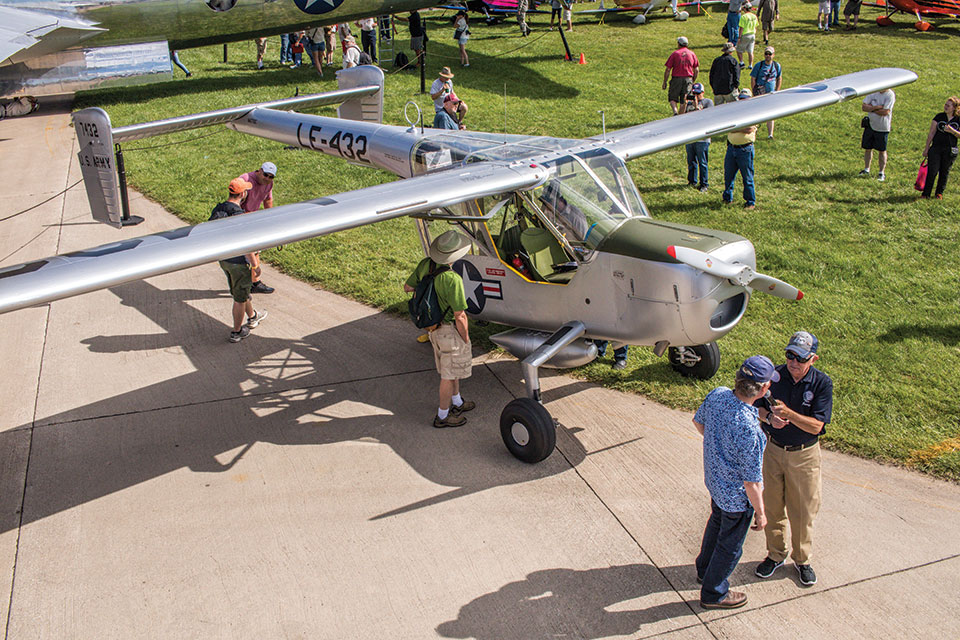YL-15 Slowly Reached for the Sky
By Frederick A. Johnsen
July 29, 2017 - After World War II, the U.S. Army went looking for a new light observation aircraft. In a competition that ultimately went to Cessna’s L-19, Boeing quickly designed its competing L-15. Boeing had, on several prior occasions, produced game-changing designs, ranging from its Model 40 mail plane to the then-radical four-engine Flying Fortress of 1935. That same game-changing grasp of aerodynamics and audacity would show up on the company’s successful sweptwing B-47 Stratojet bomber, and later on the 707 jetliner.
But the unorthodox L-15 may have been a reach too far in 1946. Its truncated fuselage featured wraparound visibility for the back-seat observer, who could swivel to face aft. A boom supports the tail surfaces. The L-15’s wing uses full-span flaperons with interconnected bucket-type spoilers. Owner Keith Brunquist of Wasilla, Alaska, says the plane has a power-on stall speed of 18 miles an hour, and it achieves its best angle of climb at 37 miles per hour. At only 20 mph indicated, with one pilot on board, Keith says the L-15 will get airborne. At that slow speed, Keith said it sometimes feels like “I’m gonna die.” He added that it’s short-coupled and tricky in a crosswind.
The unorthodoxy of the L-15 was countered in Cessna’s more mainstream L-19, which incorporated aspects of the civilian Cessna Model 170. Keith said perhaps the Army believed pilots could transition to the L-19 more easily than to the L-15. Economy of purchase may also have been a factor in the decision that limited the L-15 to a pair of prototypes and 10 service-test examples.
After the dust settled, the short run of L-15s was transferred to the U.S. Fish and Wildlife Service, where they monitored herds and chased down poachers in the early 1950s. The Fish and Wildlife pilots tried the stubby L-15s on wheels and skis, but the agency decided to standardize on more traditional airframes. The Boeing planes were surplus once more. Some sold for a thousand dollars or less, and Keith’s father, Norm Brunquist, paid $800 in February 1954 for the example now at AirVenture. The airframe had 400 hours total when the elder Brunquist acquired it.
Keith flew in the back seat as a kid, and the slightly quirky craft grew on him. At one point, his father flew the Boeing on a pair of Edo floats, a configuration Boeing originally designed as an option for the L-15. But in the 1960s, the engine began to have issues and the fabric control surfaces were showing the effects of years of outdoor parking.
The YL-15 went dormant, accumulating layers of snow each winter for 24 years, Keith said. “I was devastated when it just sat for years and years,” he remembered. After his father died, Keith was the only pilot among his siblings, so he bought it from the estate in 1994.
After getting his restoration chops on a Luscombe project, Keith started tackling the YL-15 in 2003. He dipped into his father’s stash of new-old-stock control surfaces, and original Rohm and Haas Plexiglas glazing. “Of course, the paper was stuck on there,” he said. Anyone who has ever tried to revive old Plexiglas panels still protected by adhesive paper knows how tightly it clings with age. Keith said he learned that 99 percent isopropyl alcohol on a microfiber towel can release the paper, albeit with a large amount of elbow grease. But today, this YL-15 flies with original Plexiglas installed.
The YL-15 is designed for quick disassembly. “The boom comes off the fuselage with just three bolts,” Keith said. Wing panels come off, other parts fold in, and the tiny flying machine can fit through an 8-by-8-foot opening. Boeing designed it for transport in a traditional Army deuce-and-a-half (2.5-ton) truck. Keith used a 24-foot box truck to bring the L-15 from Alaska to Anoka, Minnesota, where a team reassembled it before he flew it to Oshkosh for AirVenture 2017.
The pristine YL-15 at AirVenture features carefully masked and placed markings, which Keith positioned by locating where they had etched into the anodized aluminum skin when the airplane was new. The belly skin was corroded from years of exposure, so he reskinned that portion. To keep the finished product looking uniform and new, Keith used a silver paint on top of gray epoxy primer.
Keith modestly calls himself a low-time pilot. In addition to traditional aircraft, he has amassed about 23 hours in the YL-15 since its restoration. “It’s still a steep learning curve every time I fly it,” he said. “I’m having fun, though.”

